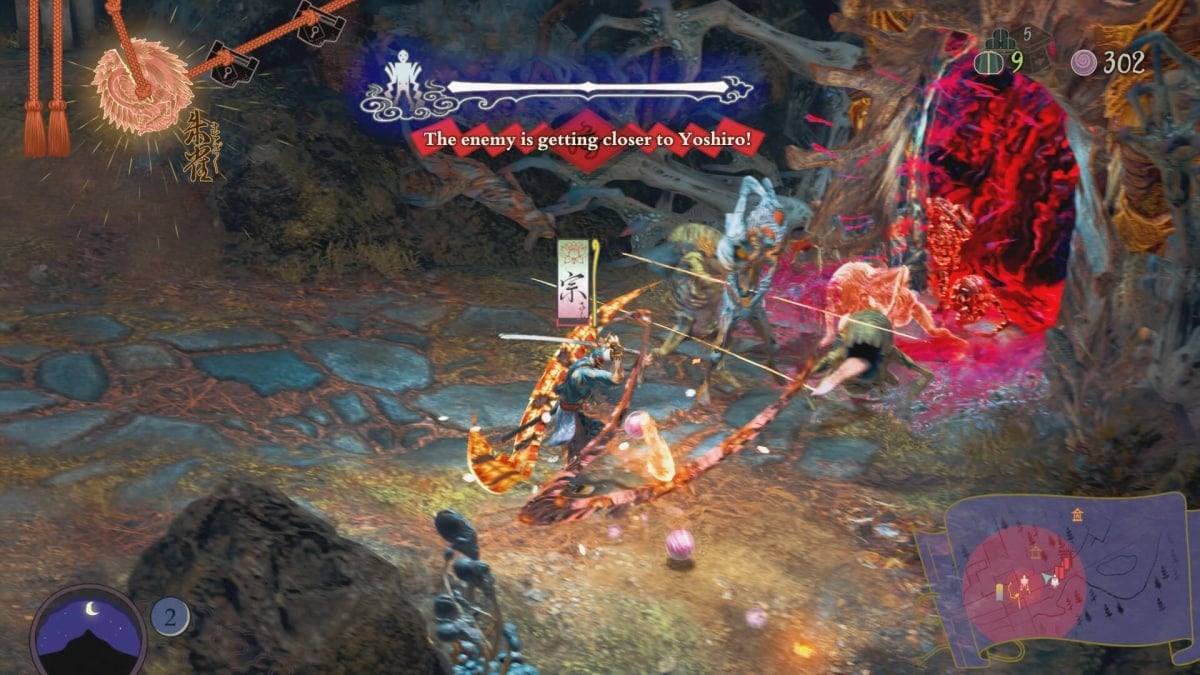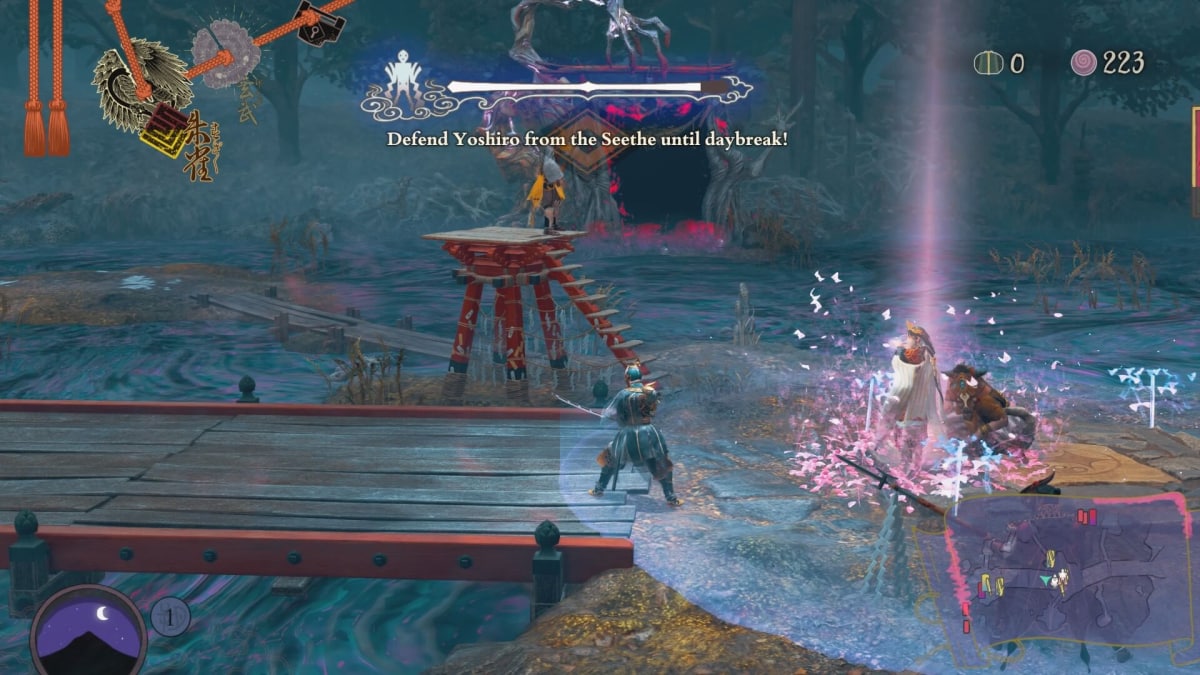Kunitsu-Gami: Path of the Goddess feels like a throwback to an earlier time in the game industry. The experimental age of the 2000s where developers had the freedom to mess around with genre convention and aesthetics. The era that spawned cult hits like God Hand, Okami, and Onimusha. In that spirit, Capcom has developed a game that blends two disparate genres, resulting in one of 2024's most pleasant surprises.
Kunitsu-Gami: Path of the Goddess Review – Following The Path
The set-up for Kunitsu-Gami: Path of the Goddess plays out like a folk tale. A mountain has become infested with a demonic force known as the Seethe. The only one who can purify the mountain is a priestess named Yoshiro. Given how lethal the Seethe is, Yoshiro summons a spirit warrior named Soh to protect her and provide guidance. But Soh is just one warrior. If they intend to save the mountain and its people, Soh must strategically recruit and command local villagers to protect Yoshiro and purify the land one step at a time.

With that simple premise, Kunitsu-Gami: Path of the Goddess frames its entire gameplay loop: a mix of third-person action, and real-time tower defense. You explore the map by day, purifying areas, recruiting villagers, and guiding Yoshiro towards a torii gate. By night, you and the villagers protect Yoshiro from waves of Seethe. Get Yoshiro to purify all torii gates in the area and you complete the level.
The idea of blending tactical strategy and fast-paced action isn't exactly new in games but Kunitsu-Gami: Path of the Goddess 'gameplay demonstrates a high level of polish and intentional design.
This is most apparent in how it melds action and strategy together. Generally, Soh's combat prowess is no different from other hack-and-slash protagonists. Light attack, heavy attack, block, and dodge. But enemy waves are aggressive and numerous.

You can feasibly bottleneck one wave of Seethe with a string of deadly attacks, but what about the two other waves coming elsewhere? You can slice through ground-based enemies, but what about the deadly aerial assassins? What happens when Seethe makes it to Yoshiro and you're on the other side of the map? What happens when you get overwhelmed?
Enter the real-time defense elements. Purifying an area grants you crystals. Crystals can be used to assign villagers different roles. These roles can range from simple axe fighters and archers to more complex sumo wrestlers and cannoneers. Crystals also purify Yoshiro's path to the torii gates, letting her progress. Do you try to get Yoshiro to the goal quickly, or do you invest in sturdy defenses and take your time?

The time and resource management in these levels compounds with the introduction of the craftsman. The craftsman can repair areas or traps in a level, which can either slow down Seethe or enhance your allies. This leads to plenty of small tactical decisions that can mean victory or defeat during the day. A single damage trap can mean the difference between being overwhelmed and getting to the end.
Like the action sections, the strategy elements of Kunitsu-Gami: Path of the Goddess are straightforward in isolation. If you're familiar with the genre, various staples are present and accounted for – cheap reliable melee and ranged units, costly support units, pricey dedicated units, etc.. But when combined with the robust enemy variety and Soh's responsive combat, the entire experience is an electric rush of time management and intense sieges.

It is a fantastic gameplay foundation made juicier with thoughtful level design. Each map in the game is compact; you can go from end to end in about a minute. Each element of the map is intentionally placed – every fork in the path, every branching path, every bottleneck. Furthermore, every single map has some unique environmental or architectural twist – managing visibility in a dark cave, coordinating naval combat on a storm-ridden lake, the list goes on.
But the biggest draw by far is how refined and effortless unit management is. Place a unit in an area, and they will attack anything within a certain area. If they're a defense unit they will buff, debuff, or heal the same way. It may not be as complex as Command & Conquer, but for something more fast-paced it works.
If there is one area where the game's combat stretches too thin, it is in the boss fights. They can range from complex multi-level tests of spatial reasoning and tactics to annoying health sponges with tedious unblockable attacks; the source of a few ragequits.

Kunitsu-Gami: Path of the Goddess Review – Restoring The Mountain
In addition to satisfying moment-to-moment gameplay, Kunitsu-Gami: Path of the Goddess' macro progression is great. Clearing levels earns you Musubi, which can be used to improve the stats of different unit types or unlock additional abilities for Soh. These improvements range from simple health and damage increases to unlocking more complex commands for your units.
Both Musubi and crystals you earn carry over between levels, adding a layer of long-term management. There were more than a few occasions where I had to make due with basic axemen and archers because I blew my crystal budget on riflemen and spearmen in a boss fight. Conversely, I put my Musubi into maxing out the basic melee and ranged units then put the remainder into Soh's tactical combat options. It let me get the most out of the cheapest options as well as provide a resource reserve if I wanted to indulge in more experimental configurations.

Musubi and crystals can also be earned through some light base management. Completing a level unlocks a purified version of it on the world map. These are hub areas where you can assign villagers to different renovation projects like fixing up a shrine or restoring destroyed jizo statues. These projects finish when you complete a certain number of levels. Because of this, you are encouraged to check back in each area, setting up new assignments and collecting rewards.
What stops these sections from becoming a tedious slog is the presentation. It's the game expressing the Shinto belief of cherishing nature as well as showing the clear progress you're having in restoring order.

Kunitsu-Gami: Path of the Goddess Review – The Same Tale Told Once More
If there is an area where Kunitsu-Gami: Path of the Goddess is lacking, it is in narrative storytelling. Gameplay-wise, the campaign is well-paced and packed with twists and turns. But in terms of story and character, it is mostly wordless cutscenes.
It mostly works thanks to the game's dedication to sensation. Everything from the kaleidoscopic art direction to the expressive dancing performance capture to the moody acoustic soundtrack is truly elevating. It is a vibe-driven experience, and the vibes are strong.
Just how rewarding is this gameplay? Upon finishing the story, New Game Plus mode unlocked, and I immediately started it. That is a testament to the craftsmanship and care Capcom put into this title, and I'm hoping it is the start of a new series.

Kunitsu-Gami: Path of the Goddess Review | Final Thoughts
A barebones story and some annoying boss fights aside, Kunitsu-Gami: Path of the Goddess is a bold, confident combination of fast-paced action and exciting tactical management. If you love action or strategy, this game is a must-play. Check it out.
Kunitsu-Gami: Path of the Goddess was reviewed on PlayStation 5 with a copy provided by Capcom over the course of 19 hours of gameplay - all screenshots were taken during the process of review.
Review Summary
Pros
- Satisfying Action Strategy Gameplay
- Imaginative, Creative Level Design
- Rewarding Progression Curve
Cons
- Annoying Boss Fights
- Narratively Light
Have a tip, or want to point out something we missed? Leave a Comment or e-mail us at tips@techraptor.net












